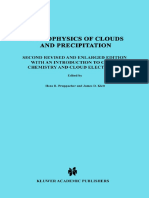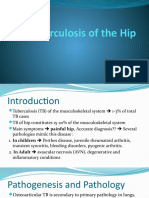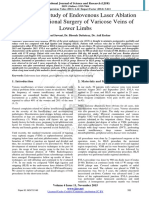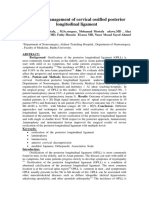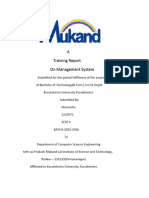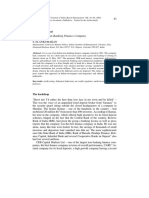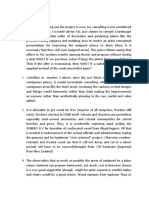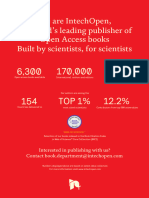Treatment of Buerger's Disease by Bone Widening by Ilizarov Technique
Treatment of Buerger's Disease by Bone Widening by Ilizarov Technique
Uploaded by
Ismah KhairinaCopyright:
Available Formats
Treatment of Buerger's Disease by Bone Widening by Ilizarov Technique
Treatment of Buerger's Disease by Bone Widening by Ilizarov Technique
Uploaded by
Ismah KhairinaOriginal Title
Copyright
Available Formats
Share this document
Did you find this document useful?
Is this content inappropriate?
Copyright:
Available Formats
Treatment of Buerger's Disease by Bone Widening by Ilizarov Technique
Treatment of Buerger's Disease by Bone Widening by Ilizarov Technique
Uploaded by
Ismah KhairinaCopyright:
Available Formats
DOI: 10.
17354/SUR/2016/10
Original Article
Treatment of Buerger’s Disease by Bone Widening
by Ilizarov Technique
Satish Nesari1, Mahaboob Pasha2
1
Assistant Professor, Department of Orthopedics, Belgaum Institute of Medical Science, Belagavi, Karnataka, India,
2
House Surgeon, Department of Orthopaedics, Belgaum Institute of Medical Science, Belagavi, Karnataka, India
Abstract
Background: Thromboangiitis obliterans (TAO) is a chronic inflammatory arteritis affecting small/medium arteries, predominantly
of lower limbs. It is difficult to get good results with conservative treatment; response rates with surgical treatment options such
as sympathectomy are inconsistent. Other options such as omentopexy are costly and have high complication rates.
Materials and Methods: Patients diagnosed with TAO were treated using bone widening technique using Ilizarov external fixator
and results analyzed.
Results: We present our early experience in managing TAO by bone widening by Ilizarov method. Ilizarov technique gave
excellent results, as indicated by subsidence of pain (though gradual), increase in peripheral capillary oxygen saturation (>95%),
and increase in claudication distance (1-5 km).
Conclusion: A bone widening technique using Ilizarov method can be a good alternative in the treatment of Buerger’s disease.
It is excellent and cost-effective method.
Keywords: Bone widening, Buerger’s disease, Gangrene, Neohistogenesis
INTRODUCTION changes in the walls of arteries and veins which
may lead to thrombosis.
T hromboangiitis Obliterans (TAO), also known as
Buerger’s disease, is a progressive, inflammatory
reaction in the arterial wall with involvement of
Carl Friedlander, in 1876, first named it as “arteritis
obliterans.”7 3 years later, in 1879, Felix von Winiwarter,
neighboring vein and nerve, terminating in thrombosis came across a case of unusual obliteration of the arteries
of the artery.1-3 TAO is a more common in males. There and veins of the leg in a 57-year-old male patient, which
may be some hormonal influence which suggests sex he termed as endarteritis obliterans. 8 Leo Buerger,
distribution.3 TAO is a disease of male smokers. Though in 1908, gave the first pathological description and
very rare, it is also seen in females.4-6 called it “presenile spontaneous gangrene.”9 As the
acute histologic features in the arteries/veins were
Definite etiology for the disease is unknown but it is characterized by thrombosis and marked inflammatory
strongly associated with smoking (primarily), also from response, he called it TAO.
the use of smokeless tobacco. It is common in age group
Clinically, TAO presents as chronic ischemia (lower
of 20-40 years. Histologically, there are inflammatory
limb>upper limb). Usually, pain is the presenting
Access this article online complaint (claudication/rest pain). Associated features
like chronic ulcers/gangrene may be present. History of
Month of Submission : 11-2015 tobacco use (smoking/smokeless tobacco) is present.
Month of Peer Review : 12-2015
Month of Acceptance : 01-2016 Although there is no permanent cure as of now, cessation of
Month of Publishing : 02-2016 tobacco in any form should be the first step/most effective
www.surgeryijss.com
step10,11 in treatment and results in disease quiescence but
Corresponding Author: Dr. Satish Nesari, House no.308, Belgaum Institute of Medical Science Doctors (Group A) Quarters, Near Civil
Hospital OPD, Belgaum Institute of Medical Science, Belgaum - 590 001, Karnataka, India. Phone: +91-9448035954.
E-mail: Satish_nesari@rediffmail.com
10 IJSS Journal of Surgery | March-April 2016 | Volume 2 | Issue 2
Nesari and Pasha: Treatment of Buerger’s Disease by Ilizarov Technique
does not reverse the disease. Various medical (platelet tibial, dorsalis pedis were not palpable, though femoral
inhibitors, vasodilators, anticoagulants, thrombolytic arterial pulsations were palpable. Peripheral capillary
therapy, clofibrate, etc.), surgical (thrombolytic therapy, oxygen saturation by pulse oximetry was not recordable.
bypass grafts, lumbar sympathectomy, omental transfer, Three out of five patients had gangrene of great toe for
etc.), and other modalities (spinal cord stimulation and which amputation (guillotine method) of great toe was
therapeutic angiogenesis) have been tried with limited done followed by bone widening by Ilizarov technique.
success. As the disease progresses, amputations may One patient had involvement of upper limb in addition
eventually be required. Periosteal stripping,12 cell therapy, with chronic ischemic features in the left hand and
vascular gene therapy,13 osteotrepanation14 are newer gangrene of left index finger/thumb. Radial/ulnar
modalities in the treatment. artery pulsations were not palpable. He had segmental
narrowing and occlusion of the brachial artery, ulnar and
GA Ilizarov has studied effect of tension stress on genesis radial arteries which were operated by vascular surgeon
and growth of tissues in canine tibiae and found that before presenting to us. After surgery, there was some
corticotomy and distraction of fragments increased improvement in pain but later as the symptoms worsened,
blood supply to the limb and led to osteogenesis and the patient was advised for above elbow amputation.
neo-histogenesis.15,16 Ilizarov technique was tried prior to amputation. As
there was considerable improvement in signs/symptoms,
Buerger’s disease can be effectively managed using amputation was avoided.
the principles of distraction osteogenesis to promote
angiogenesis. Ilizarov’s method of distraction osteogenesis Postoperatively, weight bearing was allowed soon after
increases vascularity of the ischemic limb, thereby operation. Most of the patients were able to walk at about
preventing subsequent amputations at a higher level. 7 days post-surgery.
However, it needs considerable skill and expertise and has
a long learning curve. Although distraction osteogenesis All the patients were followed up for >2 years (mean =
is shown to promote angiogenesis, using this technique 2 years 9 months).
as a treatment modality has been reported by only a few.
In the last follow-up, all the patients are able to walk for
We report here our experience in treating five patients >1.5 km and they resumed to their duties.
diagnosed to have Buerger’s disease (TAO) using bone
widening technique using Ilizarov external fixation Technique: Corticotomy was performed on the
technique. anteromedial surface of tibia (ulna in case of upper limb
TAO). Percutaneous multiple small vertical incisions were
MATERIALS AND METHODS taken. The longitudinal osteotomy was made on the
anteromedial surface of the tibia using 5 mm osteotomes.
A total of five patients diagnosed with TAO and treated This results in a small fragment of tibia (about 12-15 cm
using bone widening technique using Ilizarov external long), in the posteromedial area which is distracted
fixator were studied from March 2012 until September apart horizontally using crossed plain wires. Osteotomy
2015. fragment was fixed with cross wire technique.
History of heavy smoking (20-40 beedis/day, for Post-operative care: Regular dressings were done to
>25 years) since early age was present in all cases. All prevent pin tract infection. Physiotherapy was advised
patients had severe rest pain. All patients had Grade IV postoperatively. After a period of 7-day, distraction
ischemia as per Rutherford classification and Stage IV was started. The rate of distraction being 0.25 mm,
disease as per Leriche-Fontaine classification. Other 4 times day. Total distraction was 2-2.5 cm consolidation
possible causes of ischemia such as atherosclerosis, period was about 10 weeks. External fixator time was
Raynaud’s phenomenon were excluded before the about 12 weeks. Post-operative radiographs were taken
diagnosis of TAO was made. Relevant Investigations every 6 weeks until frame is removed.
such as color Doppler and MR angiography was done
whenever indicated. All patients had received some Patients were discharged after 10 days. Ilizarov apparatus
or the other pharmacological treatment with limited removed after about 12 weeks (Figures 1-8).
success.
RESULTS
Mean age was 43 years. Four patients had lower limb
involvement (chronic ischemic features with non- Improvement in symptoms was gradual, pain relief (rest
healing ulcer). In three patients, popliteal, posterior pain) seen after 2 weeks following treatment.
IJSS Journal of Surgery | March-April 2016 | Volume 2 | Issue 2 11
Nesari and Pasha: Treatment of Buerger’s Disease by Ilizarov Technique
Figure 1: Upper limb thromboangiitis obliterans Figure 4: Healed osteotomy site post removal (12 weeks) of
Ilizarov fixator
Figure 2: upper limb thromboangiitis obliterans operated using
Ilizarov fixator Figure 5: Osteotomy fragment fixed using crossed wire
technique and Ilizarov fixator
Figure 3: Osteotomy fragment fixed using crossed wire Figure 6: Healed osteotomy site post removal (12 weeks) of
technique and Ilizarov fixator Ilizarov fixator
In all patients, the severity of pain got reduced and changes in skin improved. By the time fixator was
dramatic improvement in claudication distance. Ischemic removed, ulcer showed signs of healing.
12 IJSS Journal of Surgery | March-April 2016 | Volume 2 | Issue 2
Nesari and Pasha: Treatment of Buerger’s Disease by Ilizarov Technique
The disease is more prevalent in middle east and asia.18
Though definite etiology is unknown the possible
etiologies include/attributed to the use of tobacco,
genetic predisposition, autonomic over activity,
autoimmune etiology.3 Pain is typical of intermittent
claudication which progresses to rest pain. Gradually,
postural color changes appear, followed by trophic
changes and eventually ulceration and gangrene of one
or more digit; finally of the entire foot and hand requiring
amputation. As the disease progresses pain becomes
intense and may be even present at rest (rest pain).
Rest pain is so intense that patient cannot sleep, some
amelioration may be achieved by placing the affected
limb in dependent position.3,17
Signs suggestive of chronic tissue ischemia are present.
The most frequent finding is the absence of posterior
tibial and dorsalis pedis pulses in the feet. Absence of
posterior tibial pulse when bilateral is highly suggestive of
the disease. In the upper extremity, the radial pulse may
be absent and when bilateral is suggestive of disease.3
Recurrent superficial thrombophlebitis is a characteristic
feature of the disease.18 Migratory superficial phlebitis
may be present in up to 16% of patients, thus indicating
Figure 7: Full weight bearing 5 days after surgery a systemic inflammatory response. 17 Some of the
characteristic angiographic findings include - disease
confinement to distal circulation, the occlusions
are segmental and show skip lesions with extensive
collateralization (corkscrew collaterals).17
Conservative treatment comprises cessation of
smoking/tobacco use. But only 43-70% of cases manage
to give up smoking. 19 Vasodilators, anti-coagulants,
dextran, phenylbutazone, steroids, prostaglandin therapy
have been tried with questionable vaue.3 The role of
sympathectomy is doubtful3,17-18 and has got aspecific
role in alleviating pain. About 50% of patients are
significantly benefitted from sympathectomy.3 Although
Figure 8: Post Ilizarov (upper limb thromboangiitis obliterans) sympathectomy is shown to promote ulcer healing and
picture showing pulse oximetry parameters provides short-term pain relief in some patients with
Buerger’s disease, no long-term benefits have been
Oxygen saturation measured using pulse oximeter was confirmed. 20 Re-vascularizing options are limited. 17
>95% (Figure 8) at the time of fixator removal. The Arterial reconstruction is difficult because of the distal
patient is able to walk bearing full weight in few days nature of the disease; amputation is the only way out
after surgery (Figure 7). when gangrene develops.3
All the patients now are able to walk >1.5 km with no Distraction osteogenesis is a surgical technique used to
pain. All patients resumed to their duties/jobs. reconstruct skeletal deformities and lengthen the bones.
A corticotomy is used to fracture the bone into two
DISCUSSION segments, and the two segments are gradually moved
apart during which new bone forms in the gap.21,22
TAO, also known as Buerger’s disease/pre-senile gangrene, Intact medullary blood supply, preservation of soft
is a progressive, segmental, non-atherosclerotic, tissue envelope, mainly the periosteum and stability of
inflammatory, vaso-occlusive disease (thrombosis) of fixator are the most important factors for success of bone
small/medium sized arteries and/or thrombophlebitis of distraction.23,24 Distraction rate must be gradual to achieve
superficial or deep veins and Raynaud’s syndrome.1-2,17 optimal results. Too slow distraction rate would result in
IJSS Journal of Surgery | March-April 2016 | Volume 2 | Issue 2 13
Nesari and Pasha: Treatment of Buerger’s Disease by Ilizarov Technique
early bone consolidation whereas rapid distraction may method. It can avoid amputations at a higher level and
result in fibrous union.25 provides relief of symptoms, may halt/retard disease
progression when accompanied by cessation of tobacco
Treatment of TAO in our study is based on the principle use in any form.
of law of tension stress by prof. Ilizarov which states
that “when living tissues are subjected to uniform REFERENCES
planar distraction forces after atraumatic corticotomy
in the presence of intact functions new tissues (bone, 1. Williams NS, Bulstrode CJ, O’Connell PR, editors. Bailey and
muscle, fascia, nerve, vessels, skin) regenerate in Love's Short practice of Surgery. London: Hodder Arnold:
the limb” neovascularization leads to increase in Arterial Disorders; Thromboangiitis Obliterans (Buerger’s
collateral circulation and blood supply is increased up Disease); 2008. p. 923-4.
to 1.5‑2.7 times. 2. Ferri FF. Ferri’s Clinical Advisor 2016: 5 Books in 1. St.
Louis: Elsevier Health Sciences; 2015. p. 1213. Available
Bone widening by Ilizarov method can be considered as from: https://www.books.google.co.in/books?id=bbLSC
best method in failed cases treated by other modality, in QAAQBAJ&printsec=frontcover&dq=Ferri%27s+Clinical
the management of TAO. +Advisor+2016&hl=en&sa=X&ved=0ahUKEwjm3-_H2
NnKAhURC44KHd3nARYQ6AEIGzAA#v=onepage&q=Fe
rri's%20Clinical%20Advisor%202016&f=false.
Factors responsible for neo-histogenesis include
3. Das S. A Concise Textbook of Surgery. 5th ed. New York:
atraumatic corticotomy, stability of fixation, intact Dr. S. Das (Publisher); 2008. p. 175-7.
function/vascularity, rate of distraction. 4. Lie JT. Thromboangiitis obliterans (Buerger’s disease) in
women. Medicine (Baltimore) 1987;66:65-72.
Ilizarov technique increases blood supply to bones/ 5. Matsushita M, Kuzuya A, Kobayashi M, Nishikimi N, Ito M,
muscles, the operative time is <1 h, the blood loss can Oba Y, et al. Buerger’s disease in a 19-year-old woman.
be minimized to <20 ml, the technique is cost-effective J Vasc Surg 2003;38:175-9.
and hospitalization needed is <10 days. The main 6. Njo KT, Smit AJ. Thromboangiitis obliterans (Buerger’s
disadvantage is pin tract infection which can be effectively d i s e a s e ) i n 2 w o m e n . N e d Ti j d s c h r G e n e e s k d
managed by regular proper dressings. 1996;140:1770‑2.
7. Buerger’s Disease-Who Named it. Available from: http://
Shevstov et al.26 studied 265 patients with TAO treated www.whonamedit.com/synd.cfm/2724.html. [Last
accessed on 2015 Nov 20].
by distraction osteogenesis and followed up for 3 years,
8. Lie JT, Mann RJ, Ludwig J. The brothers von Winiwarter,
results were good in 89% (236) patients. In a study by
Alexander (1848-1917) and Felix (1852-1931), and
Patwa et al.27 in which 60 patients were treated with thromboangiitis obliterans. Mayo Clin Proc 1979;54:802-7.
Ilizarov technique with a mean follow-up of 5.4 years, 9. Buerger L. Thrombo-angitisobliterans: A study of the
there was a significant improvement in 53 patients in vascular lesions leading to presenile spontaneous gangrene.
terms of rest pain, claudication distance, ulcer healing, Am J Med Sci 1908;136:567-80.
decrease in higher amputation. However, 18 patients 10. Mills JL Sr. Buerger’s disease in the 21 st century:
had pin tract infection and 2 fractures. 2 patients had Diagnosis, clinical features, and therapy. Semin Vasc Surg
amputation. Chaudhary et al.28 reported 30 patients 2003;16:179‑89.
with TAO managed using bone widening technique and 11. Abhishek V, Rahul T, Prabhuswamy VK. Thromboangiitis
followed up for >2 years and found that >90% had obliterans (Buerger’s disease)-current practices. Int J
good results but amputation in 3 patients and infection Inflamm 2013;2013:Article ID: 156905.
12. Kelkar BR. Induced angiogenesis for limb ischemia. Clin
in 2 cases. Fokin et al.29 studied 125 patients with TAO
Orthop Relat Res 2003;234-40.
treated using distraction osteogenesis with an average
13. Isner JM, Pieczek A, Schainfeld R, Blair R, Haley L,
follow-up of 21.6 months, 94.2% of the patients had Asahara T, et al. Clinical evidence of angiogenesis after
good results. However, 16 cases had a local infection and arterial gene transfer of phVEGF165 in patient with
2 had fracture as a complication. Kulkarni et al.30 treated ischaemic limb. Lancet 1996;348:370-4.
30 patients with Buerger’s disease using Ilizarov fixator 14. Zusmanovich FN. The treatment of obliterating
with a mean follow-up of 4.5 years and found 83.3% had arterial diseases of the extremities by a revascularizing
good results, whereas in 4 patients amputations were osteotrepanation method. Khirurgiia (Mosk) 1996;34-6.
done and 2 had infection. 15. Ilizarov GA. The tension stress effect on the genesis and
growth of tissues: Part I. The influence of stability of
fixation and soft-tissue preservation. Clin Orthop Relat Res
CONCLUSION 1989;238:249-81.
16. Ilizarov GA. The tension-stress effect on the genesis
We conclude that bone widening technique using Ilizarov and growth of tissues: Part II. The influence of the rate
method can be a good alternative in the treatment and frequency of distraction. Clin Orthop Relat Res
of Buerger’s disease. It is excellent and cost-effective 1989;263‑85.
14 IJSS Journal of Surgery | March-April 2016 | Volume 2 | Issue 2
Nesari and Pasha: Treatment of Buerger’s Disease by Ilizarov Technique
17. Brunicardi FC, Andersen DK, Billiar TR, Dunn DL, Hunter JG, osteogenesis: Part III. Gradual distraction versus acute
Pollock RE. Schwartz Principles of Surgery. Part II. 8th ed., lengthening. Plast Reconstr Surg 2001;107:441-53.
Ch. 22. New Delhi: McGraw-Hill Medical; 2004. p. 792-3. 26. Shevtsov VI, Larionov AA, Pepeliaev AG, Petrovskaia NV.
18. Townsend CM, Beauchamp RD, Evers BM, Mattox KL. Distraction osteosynthesis in occlusive diseases of the limb
Sabiston Textbook of Surgery. 18th ed., Vol. 2. Section XII arteries. Khirurgiia (Mosk) 1998;17-21.
(Vascular). Philadelphia, PA: Saunders (Elsevier); 2008. 27. Patwa JJ, Krishnan A. Buerger’s disease (Thromboangiitis
p. 1944. Obliterans)- Management by Ilizarov’s technique of
19. Boyd ST, Fremming BA. Rimonabant – a selective CB1 horizontal distraction. A retrospective study of 60 cases.
antagonist. Ann Pharmacother 2005;39:684-90. Indian J Surg 2011;73:40-7.
20. Nesargikar PN, Ajit MK, Barry PS, Nichols BJ, Chester JF. 28. Chaudhary M, Chaudhary P, Chaudhary MR. Treatment of
Lumbar chemical sympathectomy in peripheral vascular TAO by bone widening using Ilizarov technique. Indian J
disease: Does it still have a role? Int J Surg 2009;7:145-9. Surg 2001;63:389-92.
21. Paley D, Herzenberg JE, Paremain G, Bhave A. Femoral 29. Fokin AA, Fokin AA Jr, Verbovetskii LP. Short and long
lengthening over an intramedullary nail. A matched-case term results of non-standard revascularization of the lower
comparison with Ilizarov femoral lengthening. J Bone Joint extremeties. Grud Serdechnososudistaia Khir 1993;23-8.
Surg Am 1997;79:1464-80. 30. Kulkarni S, Kukarni GS, Shyam AK, Kulkarni M, Kulkarni R,
22. Aquerreta JD, Forriol F, Cañadell J. Complications of bone Kulkarni V. Management of thromboangiitis obliterans using
lengthening. Int Orthop 1994;18:299-303. distraction osteogenesis: A retrospective study. Indian J
23. Aldegheri R. Callotasis. J Paediatr Orthop B 1993;2:11-5. Orthop 2011;45:459-64.
24. Delloye C, Delefortrie G, Coutelier L, Vincent A. Bone
regenerate formation in cortical bone during distraction
lengthening. An experimental study. Clin Orthop Relat Res How to cite this article: Nesari S and Pasha M. Treatment of
1990;34-42. Buerger’s Disease by Bone Widening by Ilizarov Technique. IJSS
Journal of Surgery 2016;2(2):10-15.
25. Warren SM, Mehrara BJ, Steinbrech DS, Paccione MF,
Greenwald JA, Spector JA, et al. Rat mandibular distraction Source of Support: Nil, Conflict of Interest: None declared.
IJSS Journal of Surgery | March-April 2016 | Volume 2 | Issue 2 15
You might also like
- John Deere 4044M, 4044R, 4049M, 4049R, 4052M, 4052R, 4066M, 4066R Tractor Manual TM131019 PDFDocument31 pagesJohn Deere 4044M, 4044R, 4049M, 4049R, 4052M, 4052R, 4066M, 4066R Tractor Manual TM131019 PDFEquipment Manuals20% (5)
- (H.R. Pruppacher, J.D. Klett) Microphysics of CloudDocument978 pages(H.R. Pruppacher, J.D. Klett) Microphysics of CloudPaulo MouraNo ratings yet
- Case of OsteosarcomaDocument25 pagesCase of Osteosarcomadocs2009100% (3)
- Diagnostic Test Grade 6Document6 pagesDiagnostic Test Grade 6Juner Sydney AbabaNo ratings yet
- Tuberculosis Ofintramuscular Hematoma Post Acl Reconstruction: A Case ReportDocument3 pagesTuberculosis Ofintramuscular Hematoma Post Acl Reconstruction: A Case ReportIJAR JOURNALNo ratings yet
- tmp7DB2 TMPDocument3 pagestmp7DB2 TMPFrontiersNo ratings yet
- Popliteal Artery Entrapement SyndromeDocument29 pagesPopliteal Artery Entrapement SyndromeShahzaib AslamNo ratings yet
- Achalasia With Megaesophagus and Tracheal Compr - 2015 - International Journal oDocument3 pagesAchalasia With Megaesophagus and Tracheal Compr - 2015 - International Journal ooomculunNo ratings yet
- admin,+12+14073+Yudi6E+ format+FMI - 1Document8 pagesadmin,+12+14073+Yudi6E+ format+FMI - 1diahvscoNo ratings yet
- Hypertrophic Osteoarthropathy: An Unusual Cause of Knee Pain and Recurrent EffusionDocument3 pagesHypertrophic Osteoarthropathy: An Unusual Cause of Knee Pain and Recurrent EffusionWami FadelNo ratings yet
- 2020 - VascularDocument28 pages2020 - VascularvsurgeonkamranNo ratings yet
- Open Patellar Tendon Debridement For Treatment of Recalcitrant Patellar Tendinopathy: Indications, Technique, and Clinical Outcomes After A 2-Year Minimum Follow-UpDocument5 pagesOpen Patellar Tendon Debridement For Treatment of Recalcitrant Patellar Tendinopathy: Indications, Technique, and Clinical Outcomes After A 2-Year Minimum Follow-Upbustyeva77No ratings yet
- Tuberculosis of The HipDocument33 pagesTuberculosis of The Hipmuhammad bayu wicaksonoNo ratings yet
- Available Online Through: ISSN 2321 - 6328Document4 pagesAvailable Online Through: ISSN 2321 - 6328Anonymous SQh10rGNo ratings yet
- Case Report Peripheral Arterial Disease Vaskular 2015Document8 pagesCase Report Peripheral Arterial Disease Vaskular 2015NovrizaL SaifulNo ratings yet
- Results of Surgical TreatmentDocument4 pagesResults of Surgical TreatmentChristine Yohana SianturiNo ratings yet
- Critical Limb IschemiaDocument2 pagesCritical Limb IschemiaDorin DvornicNo ratings yet
- Open Fracture 1/3 Distal Right Fibula Grade Iiib Open Fracture Segmental Right Tibia Grade IiibDocument24 pagesOpen Fracture 1/3 Distal Right Fibula Grade Iiib Open Fracture Segmental Right Tibia Grade IiibDokter muda BedahNo ratings yet
- Comparative Study of Endovenous Laser AblationDocument3 pagesComparative Study of Endovenous Laser AblationabdulNo ratings yet
- Osteomyelitis: Staphylococcus Aureus Is The Mosy Common Infecting Microorganisms FollowingDocument8 pagesOsteomyelitis: Staphylococcus Aureus Is The Mosy Common Infecting Microorganisms FollowingSharah LondonioNo ratings yet
- ResearchDocument3 pagesResearchDr Sreeja KSNo ratings yet
- Pseudoaneurysm Following Fracture Shaft of Femur - A Plea For ConcernDocument2 pagesPseudoaneurysm Following Fracture Shaft of Femur - A Plea For ConcernInternational Organization of Scientific Research (IOSR)No ratings yet
- Extracorporeal Shock Wave Lithotripsy Under Intravenous Sedation For Treatment of UrolithiasisDocument7 pagesExtracorporeal Shock Wave Lithotripsy Under Intravenous Sedation For Treatment of UrolithiasisツコロクムワNo ratings yet
- Granulomatose Eosinophilique Avec Polyangeite: Presentations Inhabituelles. Eosinophilic Granulomatosis With Polyangiitis: Unusual PresentationsDocument5 pagesGranulomatose Eosinophilique Avec Polyangeite: Presentations Inhabituelles. Eosinophilic Granulomatosis With Polyangiitis: Unusual PresentationsIJAR JOURNALNo ratings yet
- Case ReportDocument16 pagesCase ReporthasmiaNo ratings yet
- Jake PPDocument31 pagesJake PPapi-323342594No ratings yet
- Treatment of Bone-Marrow Oedema of The Talus With The Prostacyclin Analogue IloprostDocument4 pagesTreatment of Bone-Marrow Oedema of The Talus With The Prostacyclin Analogue IloprostRajarshi MandalNo ratings yet
- Amit Murli Patel. Physical Therapy Management of Tuberculous Arthritis of The Elbow SRJI Vol - 2, Issue - 1, Year - 2013Document10 pagesAmit Murli Patel. Physical Therapy Management of Tuberculous Arthritis of The Elbow SRJI Vol - 2, Issue - 1, Year - 2013Dr. Krishna N. SharmaNo ratings yet
- Long-Term Outcome After Thrombolysis For Acute Lower Limb IschaemiaDocument9 pagesLong-Term Outcome After Thrombolysis For Acute Lower Limb IschaemiaIdham Adyasa Manggala PutraNo ratings yet
- I. Definition of OsteomyelitisDocument5 pagesI. Definition of OsteomyelitisVictor BiñasNo ratings yet
- Surgical Management of Cervical Ossified Posterior Longitudinal LigamentDocument13 pagesSurgical Management of Cervical Ossified Posterior Longitudinal Ligamentinfobusiness2010No ratings yet
- zeng2015Document5 pageszeng2015cintyaNo ratings yet
- Calcanectomy For OsteomyelitisDocument7 pagesCalcanectomy For OsteomyelitisCleff FlowersNo ratings yet
- Delayed Union 0 Nonunion - Management PrincipleDocument50 pagesDelayed Union 0 Nonunion - Management PrincipleBimnilson SinghNo ratings yet
- Casereports 3 1083Document4 pagesCasereports 3 1083nadila raudhani pNo ratings yet
- EBM Nonunion (Risk Factors of Nonunion)Document7 pagesEBM Nonunion (Risk Factors of Nonunion)AizzatulNo ratings yet
- Jaja Buerger's DiseaseDocument40 pagesJaja Buerger's DiseaseelisgretyNo ratings yet
- Hip and Pelvic Injections PDFDocument12 pagesHip and Pelvic Injections PDFVijay Kumar100% (1)
- The Ilizarov Method of TreatmentDocument20 pagesThe Ilizarov Method of Treatmentashley_magsinoNo ratings yet
- Achilles TendinopathyDocument42 pagesAchilles TendinopathyAlberto GallariniNo ratings yet
- Transforaminal Debridement With A Posterior Only.62Document6 pagesTransforaminal Debridement With A Posterior Only.62Jean Marcel Castelo VegaNo ratings yet
- Osteoarthritis: Seti Aji HadinotoDocument48 pagesOsteoarthritis: Seti Aji HadinotoSeti Aji HNo ratings yet
- Ultrasonographic Evaluation of Plantar Fasciitis After Low-Level Laser Therapy: Results of A Double-Blind, Randomized, Placebo-Controlled TrialDocument7 pagesUltrasonographic Evaluation of Plantar Fasciitis After Low-Level Laser Therapy: Results of A Double-Blind, Randomized, Placebo-Controlled TrialSri HariNo ratings yet
- 239 1078 4 PBDocument5 pages239 1078 4 PBEmiel AwadNo ratings yet
- Isquemia Cronica AMS 2Document4 pagesIsquemia Cronica AMS 2cirugiageneral.viloNo ratings yet
- Potts DiseaseDocument10 pagesPotts DiseasePamela Shiermaine FilomenoNo ratings yet
- International Journal of Orthopedics: Research & TherapyDocument5 pagesInternational Journal of Orthopedics: Research & TherapySciresNo ratings yet
- Amit Murli Patel. Physical Therapy Management of Tuberculous Arthritis of The Elbow SRJI Vol - 2, Issue - 1, Year - 2013Document10 pagesAmit Murli Patel. Physical Therapy Management of Tuberculous Arthritis of The Elbow SRJI Vol - 2, Issue - 1, Year - 2013Dr. Krishna N. SharmaNo ratings yet
- Orthopaedic Surgery Study Guide FOR Medical Students, R1S and R2SDocument17 pagesOrthopaedic Surgery Study Guide FOR Medical Students, R1S and R2SlanghalilafaNo ratings yet
- Cauda_Equina_Syndrome_A_Case_ReportDocument3 pagesCauda_Equina_Syndrome_A_Case_ReportAlaaaTarekNo ratings yet
- BUERGER's Inavasc IV Bandung 8 Nov 2013Document37 pagesBUERGER's Inavasc IV Bandung 8 Nov 2013Deviruchi GamingNo ratings yet
- Knots and Knives - 3rd EditionsDocument4 pagesKnots and Knives - 3rd EditionsNasser AlbaddaiNo ratings yet
- Hidronefrosis 2Document5 pagesHidronefrosis 2Zwinglie SandagNo ratings yet
- Arthroscopic Bursectomy For Recalcitrant Trochanteric BursitisDocument6 pagesArthroscopic Bursectomy For Recalcitrant Trochanteric BursitisGökhan PehlivanoğluNo ratings yet
- A Case Report On Buergers DiseaseDocument3 pagesA Case Report On Buergers DiseaseJohn Allan PasanaNo ratings yet
- Case Report BM 1Document6 pagesCase Report BM 1Mohamad BasofiNo ratings yet
- Gorham's Disease of Spine: Sian Pine OurnalDocument6 pagesGorham's Disease of Spine: Sian Pine OurnalGermán PulidoNo ratings yet
- Lumbar Laminectomy Surgery For Spinal StenosisDocument15 pagesLumbar Laminectomy Surgery For Spinal StenosisElizabeth Liles MartinezNo ratings yet
- JurnalDocument5 pagesJurnalFuchsia ZeinNo ratings yet
- Role of Lnfrainguinal Bypass in Buerger's Disease: An Eighteen-Year ExperienceDocument8 pagesRole of Lnfrainguinal Bypass in Buerger's Disease: An Eighteen-Year ExperienceAkbar Eka PutraNo ratings yet
- Management of Cauda Equina Syndrome by Full Endoscopic Interlaminar Decompression A Case ReportDocument4 pagesManagement of Cauda Equina Syndrome by Full Endoscopic Interlaminar Decompression A Case ReportInternational Journal of Innovative Science and Research TechnologyNo ratings yet
- Rthopaedics Ed Flag Emergencies: Staph Aureus, H. Influenzae and Enterobacter (In Children)Document13 pagesRthopaedics Ed Flag Emergencies: Staph Aureus, H. Influenzae and Enterobacter (In Children)rocitaho1458No ratings yet
- BSBTWK301 Assessment.v1.0Document37 pagesBSBTWK301 Assessment.v1.01320382893No ratings yet
- The Role of Epigenetic Regulation of MTSS1 Gene in Glioma Cell MotilityDocument20 pagesThe Role of Epigenetic Regulation of MTSS1 Gene in Glioma Cell MotilityYağış BeyNo ratings yet
- Catalogue Icc en 2020Document126 pagesCatalogue Icc en 2020michael esoNo ratings yet
- Lesson Plan: Unit 1: My Funny Friend Lesson 7&8: Listening, Speaking and WritingDocument4 pagesLesson Plan: Unit 1: My Funny Friend Lesson 7&8: Listening, Speaking and WritingThúy Võ ThịNo ratings yet
- CN6000Document3 pagesCN6000dwijokopurnomo21_362No ratings yet
- House Price Prediction Using Machine Learning TechniquesDocument5 pagesHouse Price Prediction Using Machine Learning TechniquesVishal JoshiNo ratings yet
- JenCo - Electrical Systems O&MsDocument113 pagesJenCo - Electrical Systems O&MsNadia EspinozaNo ratings yet
- Chase 2024Document4 pagesChase 2024WEBTREE TECHNOLOGYNo ratings yet
- Costing Sungi KotaDocument2 pagesCosting Sungi KotaAnonymous UUw70xirblNo ratings yet
- HimanshuDocument30 pagesHimanshuvinaysaini3004No ratings yet
- Lect5 FSMDocument23 pagesLect5 FSMSangeetha BajanthriNo ratings yet
- TBChap 009Document22 pagesTBChap 009sany030809No ratings yet
- Chhattisgarh Swami Vivekanand Technical University, Bhilai: InstituteDocument10 pagesChhattisgarh Swami Vivekanand Technical University, Bhilai: InstituteMukesh BishtNo ratings yet
- JDDocument27 pagesJDMallu SailajaNo ratings yet
- Caveat EmptorDocument14 pagesCaveat EmptorKarthik S VNo ratings yet
- Objectives Topic/S Classroom-Based Activities Home-Based ActivitiesDocument2 pagesObjectives Topic/S Classroom-Based Activities Home-Based ActivitiesLorie Grace Catalogo BaguioNo ratings yet
- Adobe Pagemaker 6.5 Tutorial ManualsDocument490 pagesAdobe Pagemaker 6.5 Tutorial ManualsmannycarNo ratings yet
- NSTP SUGGESTionDocument3 pagesNSTP SUGGESTionRose Ann Espinas TenaNo ratings yet
- Performance Analysis and Comparison of Various FACTS Devices in Power SystemDocument7 pagesPerformance Analysis and Comparison of Various FACTS Devices in Power SystemWaqar Ali SherNo ratings yet
- 2022 - Cap Carte - Basic Functional Application For Natural Fibers and Types - SlabutaDocument15 pages2022 - Cap Carte - Basic Functional Application For Natural Fibers and Types - SlabutatavibastiNo ratings yet
- Boeing 787:case Analysis: Ashish Jude MichaelDocument15 pagesBoeing 787:case Analysis: Ashish Jude MichaelprashantNo ratings yet
- India's Renewable Energy Generation ReportDocument30 pagesIndia's Renewable Energy Generation ReportshaileshsjNo ratings yet
- Stat Lecture 1Document49 pagesStat Lecture 1Claire Bernadette Sinay AbadNo ratings yet
- p2.Sr Mpc (Cat-b & c) Revison Assignment _wave Motion-(02!12!204 to 07-12-2024)Document7 pagesp2.Sr Mpc (Cat-b & c) Revison Assignment _wave Motion-(02!12!204 to 07-12-2024)kotthasriishtaNo ratings yet
- Module 4 - Part 1Document22 pagesModule 4 - Part 1Jan Erika AlmeronNo ratings yet
- Designing Effective Static Tests For Spacecraft Structures - Sarafin (Ler) - Part5Document1 pageDesigning Effective Static Tests For Spacecraft Structures - Sarafin (Ler) - Part5JizzPontesNo ratings yet
- ON/OFF Zone Valves (PN 16) AMZ 112, AMZ 113: Data SheetDocument8 pagesON/OFF Zone Valves (PN 16) AMZ 112, AMZ 113: Data SheetAndrei-Lucian MilitaruNo ratings yet

